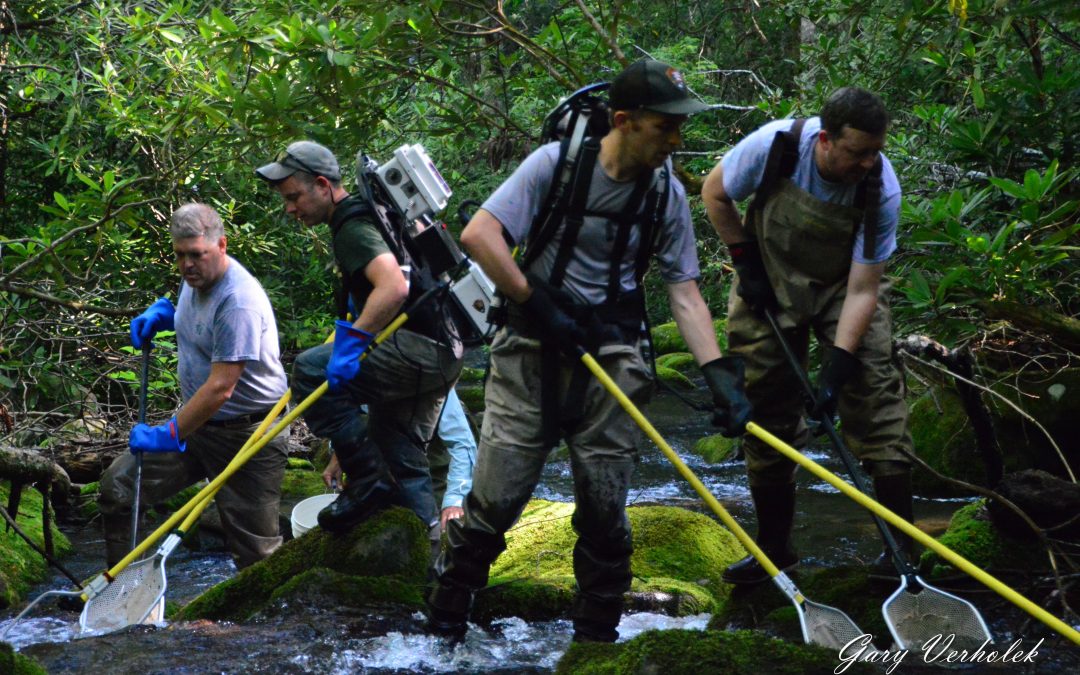Brook Trout Restoration
Land O’ Sky Trout Unlimited regularly works with Great Smoky Mountain National Park (GRSM) fishery biologists on brook trout restoration in the Smokies. An update on that work has been published in the GRSM fisheries newsletter “The Stream Guardian,” showcasing the great work being done on Brook Trout Restoration, excepted below.
Once upon a time, the Brook Trout (Salvelinus fontinalis) was abundant and widely distributed within eastern North America. These fish thrived in the cold, clean streams where they reigned as the only native salmonid in Appalachia. These incredible fish were perfectly adapted for life in these waters… until the very waters they were built to survive in began to change.
As timber companies and settlers changed the land around them by logging and farming, the loose soil once held by roots was washed into the streams, and the cool waters once shaded by the trees became too warm without the dense canopy to protect them. In addition, logging companies and the National Park Service (NPS) stocked over 1.4 million non-native rainbow trout (Oncorhynchus mykiss) into park streams, which outcompeted and further displaced native Brook Trout populations.

2016
In 2016, the NPS began efforts to restore Anthony Creek by dividing the stream above a barrier mill dam into 34, 100-meter sections and removing non–native rainbow trout using the 3-Pass Depletion method and backpack electrofishing units. Backpack electrofishing units send 600-700 volts of electricity into the water, which stuns the fish, and allows backup netters to net and capture the non-native Rainbow Trout. Each section is worked through three times to ensure a high capture rate. Using this method 2,284 Rainbow Trout, or 99.3 percent of the trout population, were removed in 2016.
2017
In 2017, the NPS conducted a second effort to remove Rainbow Trout from the area, which resulted in the capture of an additional 52 Rainbow Trout. Following the removal of all non-native Rainbow Trout, the NPS began the reintroduction of Brook Trout from local source streams. The first reintroduction collected 269 Brook Trout from Bunches Creek and relocated the fish to Anthony Creek in hopes of establishing the Brook Trout population. Bunches Creek, located near Balsam Mountain, NC, was selected for the source stock as the stream lies within the same Little Tennessee River watershed as Anthony Creek and the Brook Trout were known to be genetically pure Little Tennessee drainage fish.
2018
In 2018, the NPS continued reintroduction efforts by capturing approximately 230 Brook Trout from Deep Creek and Sahlee Creek within the Deep Creek watershed (also a genetically pure Little Tennessee tributary). With the help of our friends from the NPS trails crew and their trusty mules, the fisheries crew were able to haul the trout safely up the mountain trail, and from there transport them to Anthony Creek. If all goes as planned, these new recruits will disperse, multiply, and reach carrying capacity within 3 years. For more about our adventure with the mules visit: https://friendsofthesmokies.org/blog/have-you-ever-been-fishing-with-a-mule/
2017
The restoration of Little Cataloochee Creek began in 2017. Due to the large size of the stream, holes over 3-4 feet deep, and the generally complex habitat in Little Cataloochee a different removal method was necessary. Instead of backpack electrofishing, the EPA approved piscicide Antimycin A, was utilized to remove Rainbow Trout from a 3- mile section of stream. Antimycin A acts by inhibiting cellular respiration of fish, including Rainbow Trout. One 8-hour treatment of Antimycin A depleted all Rainbow Trout within the restored section of Little Cataloochee Creek. Below the barrier waterfall at the lower end of the treatment zone, the antimycin was neutralized using potassium permanganate (KMnO4); once neutralized, the antimycin becomes ineffective and no fish are killed downstream of the barrier falls. Given Little Cataloochee Creek included both Rainbow and Brook Trout, prior to Antimycin A application, a significant effort was made to remove all Brook Trout from the treatment sections with backpack electrofishing and hold them in a large tank or untreated headwater areas until treatment was complete. Once treatment was complete, the captive Brook Trout were redistributed to the newly reclaimed stream segments.
2018
In 2018, the stream was monitored to evaluate the condition of the reintroduced Brook Trout. An additional 151 Brook Trout were captured from Correll Branch and transported to Little Cataloochee Creek to augment the existing population. The 2018 Brook Trout population surveys indicate Little Cataloochee Creek is recovering very nicely and should be back to carrying capacity within three years. The successful restoration of Little Cataloochee Creek brings the total number of Brook Trout streams restored within GRSM to 13 and includes 30.5 miles of stream habitat.
Since the 1900s, the Brook Trout, which were once abundant, declined by 75% in Great Smoky Mountain National Park (GRSM) due to logging practices performed before the creation of the park in 1934. Even as the forests began to grow back, the sky above became polluted from the gas released from factories, cars, and power plants. The rain that once brought relief to the drying earth below, now brought an assault of acid that altered the chemistry of the soil and the streams making them inhospitable to Brook Trout.
The hardships that came with the changes to their habitat were only compounded by the introduction and expansion of non-native Rainbow Trout from the West. With their habitat altered by humans and new competitors dominating their territory, Brook Trout populations continued to decline through the mid-1900s. The NPS sought to restore the Brook Trout not just because they are native to the local streams and rivers where they have dwelled for millennia, but because these fish are intertwined with southern Appalachian heritage.
These Brook Trout are the descendants of those who saw the first European settlers arrive in Tennessee, the same lineage as those who supported Native American settlements for centuries, and of the same blood as those who knew these waters when they were fed by the glaciers covering North America.
We encourage you to download the newsletter.
Take care of the fish, and the fishing will take care of itself.
Links and Resources
- Appalachian Brook Trout: Learn more about North Carolina's native trout, which isn't really a trout.
- A Native Son Returns: What North Carolina is doing to understand and preserve our native brookies.
- Davidson River Report: 2003/2017 Habitat Inventories Comparison (PNF/Pisgah District).
- TU Status Report: A report on the TU/USFS Southern Appalachian Aquatic Habitat Connectivity Partnership.

